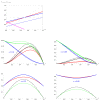Unanimity, Coexistence, and Rigidity: Three Sides of Polarization
- PMID: 37190410
- PMCID: PMC10138023
- DOI: 10.3390/e25040622
Unanimity, Coexistence, and Rigidity: Three Sides of Polarization
Abstract
Political polarization is perceived as a threat to democracies. Using the Galam model of opinion dynamics deployed in a five-dimensional parameter space, I show that polarization is the byproduct of an essential hallmark of a vibrant democratic society, namely open and informal discussions among agents. Indeed, within a homogeneous social community with floaters, the dynamics lead gradually toward unanimity (zero entropy). Polarization can eventually appear as the juxtaposition of non-mixing social groups sharing different prejudices about the issue at stake. On the other hand, the inclusion of contrarian agents produces a polarization within a community that mixes when their proportion x is beyond a critical value xc=16≈0.167 for discussing groups of size three and four. Similarly, the presence of stubborn agents also produces a polarization of a community that mixes when the proportion of stubborn agents is greater than some critical value. For equal proportions of stubborn agents a along each opinion, ac=29≈0.22 for group size four against ac=14=0.25 for group size three. However, the evaluation of the proportion of individual opinion shifts at the attractor 12 and indicates that the polarization produced by contrarians is fluid with a good deal of agents who keep shifting between the two opposed blocks (high entropy). That favors a coexistence of opposite opinions in a divided community. In contrast, the polarization created by stubborn agents is found to be frozen with very few individuals shifting opinion between the two opinions (low entropy). That yields a basis for the emergence of hate between the frozen opposed blocks.
Keywords: contrarians; opinion dynamics; polarization; prejudices; sociophysics; stubbornness.
Conflict of interest statement
The author declares no conflict of interest.
Figures






Similar articles
-
Democratic Thwarting of Majority Rule in Opinion Dynamics: 1. Unavowed Prejudices Versus Contrarians.Entropy (Basel). 2025 Mar 14;27(3):306. doi: 10.3390/e27030306. Entropy (Basel). 2025. PMID: 40149230 Free PMC article.
-
Asymmetric Contrarians in Opinion Dynamics.Entropy (Basel). 2019 Dec 24;22(1):25. doi: 10.3390/e22010025. Entropy (Basel). 2019. PMID: 33285800 Free PMC article.
-
Voter models with contrarian agents.Phys Rev E Stat Nonlin Soft Matter Phys. 2013 Nov;88(5):052803. doi: 10.1103/PhysRevE.88.052803. Epub 2013 Nov 4. Phys Rev E Stat Nonlin Soft Matter Phys. 2013. PMID: 24329314
-
Chaotic, staggered, and polarized dynamics in opinion forming: The contrarian effect.Phys Rev E Stat Nonlin Soft Matter Phys. 2006 Jun;73(6 Pt 2):066118. doi: 10.1103/PhysRevE.73.066118. Epub 2006 Jun 14. Phys Rev E Stat Nonlin Soft Matter Phys. 2006. PMID: 16906925
-
Online interventions for reducing hate speech and cyberhate: A systematic review.Campbell Syst Rev. 2022 May 25;18(2):e1243. doi: 10.1002/cl2.1243. eCollection 2022 Jun. Campbell Syst Rev. 2022. PMID: 36913206 Free PMC article. Review.
Cited by
-
Success-driven opinion formation determines social tensions.iScience. 2024 Feb 16;27(3):109254. doi: 10.1016/j.isci.2024.109254. eCollection 2024 Mar 15. iScience. 2024. PMID: 38444611 Free PMC article.
-
Democratic Thwarting of Majority Rule in Opinion Dynamics: 1. Unavowed Prejudices Versus Contrarians.Entropy (Basel). 2025 Mar 14;27(3):306. doi: 10.3390/e27030306. Entropy (Basel). 2025. PMID: 40149230 Free PMC article.
-
Modeling opinion misperception and the emergence of silence in online social system.PLoS One. 2024 Jan 11;19(1):e0296075. doi: 10.1371/journal.pone.0296075. eCollection 2024. PLoS One. 2024. PMID: 38206989 Free PMC article.
-
How out-group animosity can shape partisan divisions: A model of affective polarization.PNAS Nexus. 2025 Mar 11;4(3):pgaf082. doi: 10.1093/pnasnexus/pgaf082. eCollection 2025 Mar. PNAS Nexus. 2025. PMID: 40125444 Free PMC article.
-
Hybrid Galam-Bass Model for Technology Innovation.Entropy (Basel). 2025 Jul 25;27(8):789. doi: 10.3390/e27080789. Entropy (Basel). 2025. PMID: 40870261 Free PMC article.
References
-
- Baumann F., Lorenz-Spreen P., Sokolov I.M., Starnini M. Emergence of polarized ideological opinions in multidimensional topic spaces. Phys. Rev. 2021;11:011012. doi: 10.1103/PhysRevX.11.011012. - DOI
LinkOut - more resources
Full Text Sources

